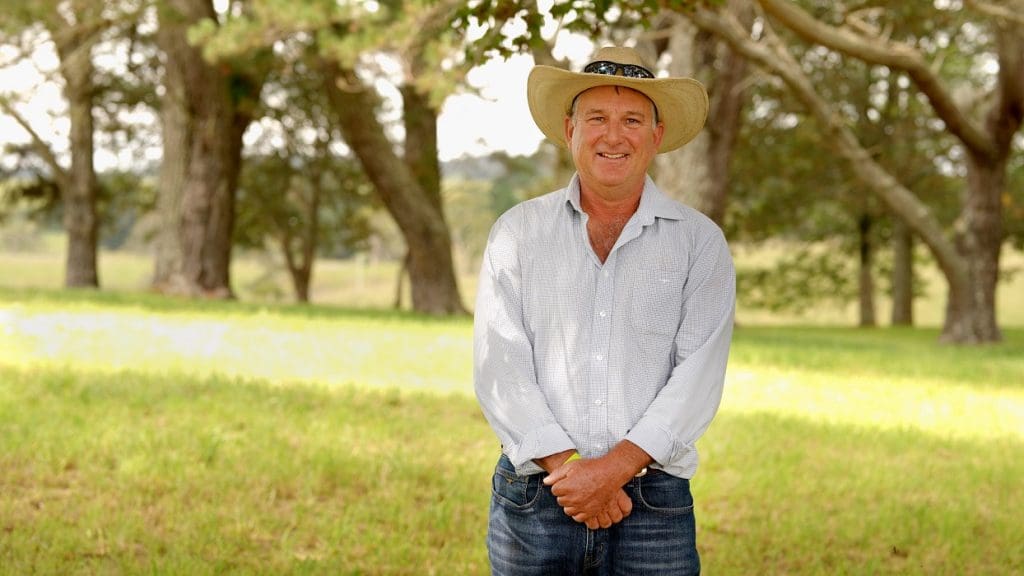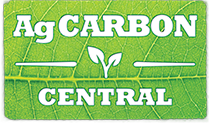
NSW sheep and cattle producer Scott Brown.
NEW South Wales sheep and cattle producer Scott Brown operates by a simple motto: ‘more testing, less guessing’.
It’s a guiding principle intertwined with Scott’s latest challenge – implementing a soil carbon project on his 800 hectare property at Trunkey Creek, south of Bathurst.
While it’s early days, with the project awaiting registration with the Emissions Reduction Fund, he has high hopes on the broad range of benefits from improved soil health and is champing at the bit to kick more goals.
The Browns’ property has been in the family since 1909. Scott and his wife Karen took over the reins from his parents around 15 years ago, and he proudly notes their three daughters are the fifth generation to call the property home.
Despite this legacy, Scott is not one to sit back and keep doing things the way they’ve always been done.
This willingness to adapt has seen the business adjust from a breeding herd to trade cattle, while the self-replacing Merino enterprise has evolved to improve reproductive performance.
Scott works on a 6.75 DSE/ha stocking rate, comprised of:
70 trade cattle: Scott buys Angus heifers from local markets in April and takes them through to feeder weight, aiming to turn them off by Christmas.
3,660 sheep: Interrogating data from EID tags and introducing genetics aimed at lamb survival has pushed marking percentages up from 75 percent to 120pc (100pc in maidens).
While Scott’s quest to formally improve carbon levels in his soil is new, the roots go back to when he took over from his father and had an aim to move away from set stocking to a more time based grazing rotation.
Scott has increased his knowledge about feedbase and livestock management through programs such as Lambs Alive, Grazing for Profit, and Lifetime Ewe Management. He has also worked hard to improve his understanding of Australian Sheep Breeding Values and gain confidence to use them properly in ram selection.
“A message out of this was: big mobs, small paddocks, high stock impact,” he said.
As he gains more confidence with rotational grazing, Scott plans on increasing mob size to aid pasture rest periods and, in turn, increase soil carbon. Smaller mobs will still be used for lambing.
“Since experimenting with changes to grazing practices, I can really see how we’re managing grass better after 100 years of set stocking. For example, Phalaris was growing back in paddocks I didn’t realise it had even been planted in, and some native species have also returned,” Scott said.
He’s observed other benefits, including:
extended feed on offer (FOO) to bridge autumn feed gaps
stock graze pastures more evenly, rather than preferentially grazing specific species
a move away from sheep camps, to reduce the associated weeds, nutrient run-off and soil compaction
“While it’s still very early on along the journey, plant health is a major benefit, and will hopefully bring less input costs and, over time, an increase in stock productivity.”
Data-driven decisions
In keeping with his motto, Scott wasn’t content with just guessing what was happening – he wanted to record the results of his practices and found the solution with MaiaGrazing.
He uses the grazing management software to record data such as grazing periods and FOO, to guide decisions around pasture, hand-in-hand with his own observations about what’s happening in the paddock.
It proved to also be the stepping stone to starting thinking about building soil carbon, a concept he had been toying with but was unsure where to start.
“Soil carbon was front of mind, as I’d heard so much about it.
“There’s been quite a few properties in our area converted to tree plantations, but I knew I didn’t want to go down that route as you lose the ability to graze on this land,” he said.
“About two years ago, I saw an ad for Atlas Carbon – I knew they were connected with MaiaGrazing, which I’ve had such a great relationship with, so it caught my attention.”
Scott said the process was simple, starting with an introductory conversation with the Atlas Carbon team to see if his business was a candidate for a soil carbon project.
As part of this, he received a free soil carbon cost-benefit analysis that laid out the establishment costs of a project as well as a break-down of investment across the 25-year life of the project, including infrastructure, pasture development, administration costs and soil testing. It also calculated production uplifts and the anticipated Australian Carbon Credit Units (ACCU) generated.
“This first step was free, so it was a way to dip my toe into the soil carbon water without any risk.
“I had the chance to see if I wanted to work with Atlas Carbon and likewise, they had the chance to see if my business was a good fit for them,” he said.
“It was about building trust.”
He was surprised at the calculations, which reinforced going forward with a project was a good fit for his business goals.
“It’s easy to say – well, how can anyone forecast what a carbon credit will be worth in 25 years,” Scott said.
“My response is – well, it’s bloody hard to forecast the sheep market next year.
“The way I look at it is, the forecasted income from my soil carbon project equates to an extra wool clip every four years,” he said.
“It can give me an off-farm income without leaving the farm.”
A blueprint for the future
The next step was to enter Atlas Carbon’s Blueprint Program, involving on-farm visits from soil and pasture specialists who ground-truthed the project’s potential. This included:
taking soil and pasture samples
understanding Scott’s business and goals
identifying new practices to improve soil carbon.
“We sat around the kitchen table and had a really good chat – even though the team at Atlas Carbon are experts in their field, they never pressured me into making any changes.
“They provided suggestions, but ultimately it came down to me to make the call about what management changes I would make.”
The result was a tailored report that gave Scott a clearer idea of how he could build and maintain carbon against management targets, to guide his eventual decision to commit to a soil carbon project.
From water and wire to the mind
Scott was on the right path to undertake a soil carbon project as he was already using MaiaGrazing to record information required to implement the grazing management principes underpinning his project, such as pasture rest periods and DSE/ha and DSE days/ha/100mm.
He will continue splitting larger paddocks into more manageable areas based on land type. The largest paddock is currently 80ha – due to terrain – which will be fenced down to more controlled areas, closer to 10ha paddocks.
Scott said the biggest challenge he’s faced in the soil carbon journey isn’t out in the paddock – but in his own mind.
“I’m starting to think of myself as a grass farmer, not a sheep producer. It sounds simple but it did take a bit to get my head around – and I still am,” he said.
“My project aims to increase soil carbon by achieving year-round grass growth through grazing pressure.
“This means grazing management decisions need to focus on striving for green growth for as much of the year as possible – rather than just livestock production goals.”
Scott said soil carbon project is not a set-and-forget approach, and it required producers to demonstrate improved soil carbon from management changes.
“It’s so easy to just keep doing the same thing, so it was really invigorating to try something different.
“I always say, if you’re not trying something new then you’re going backward,” Scott said.
Feedbase management is a priority
Scott’s property features undulating basalt country with 8km of creek running through it and around 140ha of scrub. The annual rainfall is 850-900mm and winter-dominant.
To improve soil carbon levels, he will intensify grazing practices which focus on achieving plant recovery, deepening plant root depth and biomass cycling. There will also be investment in pasture renovation, improving soil through inputs, and soil sampling to establish soil carbon changes compared with initial baseline tests.
His aim is to promote diverse pasture species, rather than a monoculture, for year-round grass production and to improve biodiversity.
As well as his existing recipe of Phalaris, cocksfoot, ryegrass and clovers, Scott is introducing new varieties such as chicory, Tonic plantain and radishes. These varieties have deep tap roots, which further enhance soil carbon capture at depth.
“Strategic grazing to promote pasture rest and recovery is critical to get extra growth into plants, to encourage their roots to grow deeper into the soil to increase soil carbon.”
On-ground cost benefits in the future
Although potential income from Scott’s soil carbon project won’t occur until between three to five years after it’s registered, he expects to see a range of other cost-savings from practice change.
One of these is reduced input costs.
“It’s all about being more strategic with using the correct rates for lime and fertiliser from the use of detailed soil sampling,” Scott said.
“The recommendation for the country tested so far is to apply low rates of lime for increased soil health. Increasing soil health and biodiversity will be an important part of the future, and better management will achieve greater plant persistence – that will decrease the major costs of resowing pasture every 8-10 years.”
While he waits for the soil carbon project to be registered, Scott has no hesitation in the 25-year contract.
“While I have no plans on selling this property, if I was to sell, then the project is sold with the property.
“I can’t see that being a problem – I reckon it’s a valuable thing to have in the business, especially the way the banks are going with green loans,” he said.
“A soil carbon project like this is one of the few ways sheep and cattle producers can make money out of carbon without taking grazing land out of the business by planting trees.”
For other producers considering a soil carbon journey, Scott’s advice is simple:
“You’ve got to be in the right mind frame to do it properly, you have to be open to change, and you have to find a company which gives you confidence in the outcomes.
“There’s no way I could have navigated a soil carbon project on my own, it’s so complex, so I really value Atlas Carbon’s expert advice and the way we’re on the journey together.”

HAVE YOUR SAY